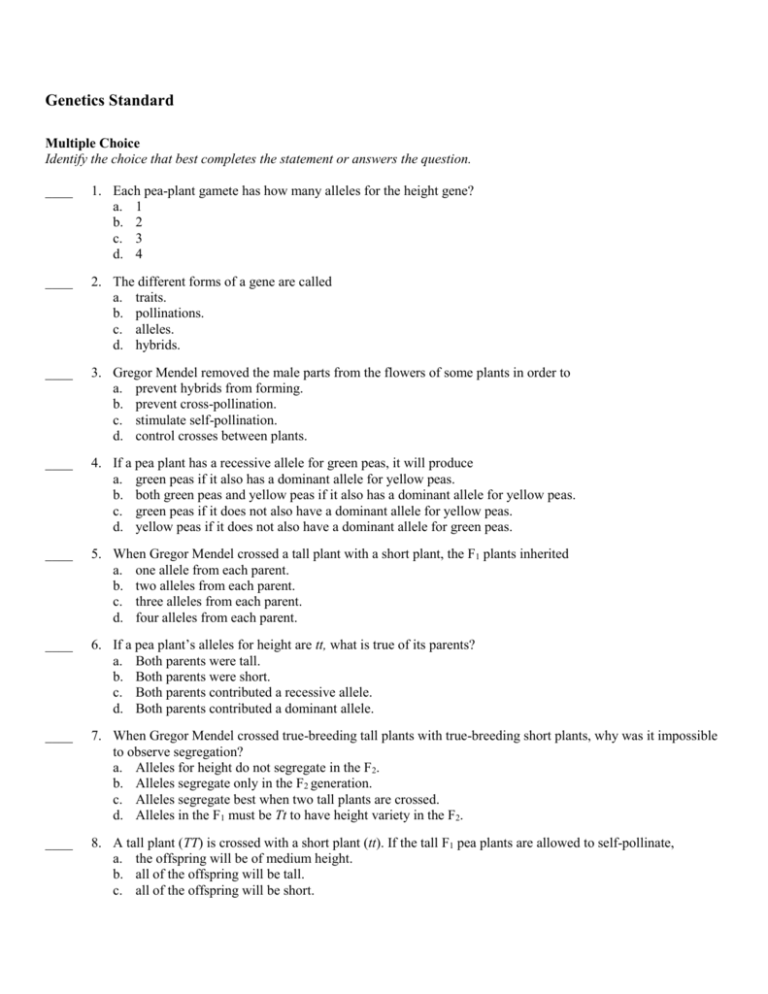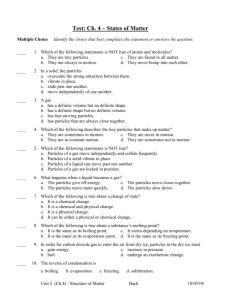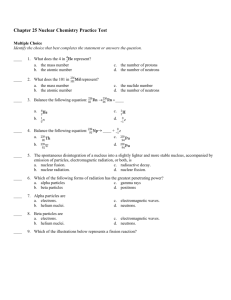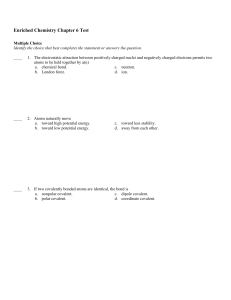Genetics Standard Test: Multiple Choice Questions
advertisement

Genetics Standard Multiple Choice Identify the choice that best completes the statement or answers the question. ____ 1. Each pea-plant gamete has how many alleles for the height gene? a. 1 b. 2 c. 3 d. 4 ____ 2. The different forms of a gene are called a. traits. b. pollinations. c. alleles. d. hybrids. ____ 3. Gregor Mendel removed the male parts from the flowers of some plants in order to a. prevent hybrids from forming. b. prevent cross-pollination. c. stimulate self-pollination. d. control crosses between plants. ____ 4. If a pea plant has a recessive allele for green peas, it will produce a. green peas if it also has a dominant allele for yellow peas. b. both green peas and yellow peas if it also has a dominant allele for yellow peas. c. green peas if it does not also have a dominant allele for yellow peas. d. yellow peas if it does not also have a dominant allele for green peas. ____ 5. When Gregor Mendel crossed a tall plant with a short plant, the F1 plants inherited a. one allele from each parent. b. two alleles from each parent. c. three alleles from each parent. d. four alleles from each parent. ____ 6. If a pea plant’s alleles for height are tt, what is true of its parents? a. Both parents were tall. b. Both parents were short. c. Both parents contributed a recessive allele. d. Both parents contributed a dominant allele. ____ 7. When Gregor Mendel crossed true-breeding tall plants with true-breeding short plants, why was it impossible to observe segregation? a. Alleles for height do not segregate in the F2. b. Alleles segregate only in the F2 generation. c. Alleles segregate best when two tall plants are crossed. d. Alleles in the F1 must be Tt to have height variety in the F2. ____ 8. A tall plant (TT) is crossed with a short plant (tt). If the tall F1 pea plants are allowed to self-pollinate, a. the offspring will be of medium height. b. all of the offspring will be tall. c. all of the offspring will be short. d. the offspring can be tall or short. ____ 9. In the P generation, a tall plant was crossed with a short plant. Short plants reappeared in the F2 generation because a. the allele for shortness becomes more common in the F2 generation. b. the allele for shortness becomes dominant in the F2 generation. c. the alleles for both heights segregated when the F1 plants made gametes. d. the alleles for tallness begin to disappear in the F2 generation. ____ 10. When you flip a coin, what is the probability that it will come up tails? a. 1 b. 1/2 c. 1/4 d. 1/8 ____ 11. The principles of probability can be used to a. predict the traits of the offspring of genetic crosses. b. determine the actual outcomes of genetic crosses. c. determine which species should be used in genetic crosses. d. decide which organisms are best to use in genetic crosses. ____ 12. A heterozygous tall pea plant is crossed with a short plant. The probability that an F1 plant will be tall is a. 25%. b. 50%. c. 75%. d. 100%. ____ 13. Organisms that have two identical alleles for a particular trait are said to be a. hybrid. b. homozygous. c. heterozygous. d. dominant. Tt T t T TT Tt T TT Tt TT T = Tall t = Short Figure 11–1 ____ 14. In the Punnett square shown in Figure 11–1, which of the following is true about the offspring resulting from the cross? a. About half are expected to be short. b. All are expected to be short. c. About three fourths are expected to be tall. d. All are expected to be tall. ____ 15. What principle states that during gamete formation genes for different traits separate without influencing each other’s inheritance? a. principle of dominance b. principle of independent assortment c. principle of probabilities d. principle of segregation RrYy RY Ry rY ry RY RRYY RRYy RrYY RrYy Ry RRYy RRyy RrYy Rryy RrYy rY RrYY RrYy rrYY rrYy ry RrYy Rryy rrYy rryy Seed Shape R = Round r = Wrinkled Seed Color Y = Yellow y = Green Figure 11–2 ____ 16. The Punnett square in Figure 11–2 shows that the gene for pea shape and the gene for pea color a. assort independently. b. are linked. c. have the same alleles. d. are always homozygous. ____ 17. How many different allele combinations would be found in the gametes produced by a pea plant whose genotype was RrYY? a. 2 b. 4 c. 8 d. 16 RRYy RrYy RY Ry rY ry RY RRYY RRYy RrYY RrYy Ry RRYy RRyy RrYy Rryy RY RRYY RrYy RrYY RrYy Ry RRYy RRyy RrYy Rryy Figure 11–3 ____ 18. Use Figure 11–3 to answer the following question. If a pea plant that is heterozygous for round, yellow peas (RrYy) is crossed with a pea plant that is homozygous for round peas but heterozygous for yellow peas (RRYy), how many different phenotypes are their offspring expected to show? a. 2 b. 4 c. 8 d. 16 ____ 19. Gregor Mendel’s principles of genetics apply to a. plants only. b. animals only. c. pea plants only. d. all organisms. ____ 20. Why did Thomas Hunt Morgan use fruit flies in his studies? a. Fruit flies produce a large number of offspring. b. Fruit flies take a long time to produce offspring. c. Fruit flies share certain characteristics with pea plants. d. Fruit flies have a long life span. ____ 21. A male and female bison that are both heterozygous for normal skin pigmentation (Aa) produce an albino offspring (aa). Which of Mendel’s principles explain(s) why the offspring is albino? a. dominance only b. independent assortment only c. dominance and segregation d. segregation only ____ 22. Roan cattle show codominance for the color of their hair. There are alleles for red hair and white hair. What would you expect a heterozygous roan bull to look like if the trait showed incomplete dominance instead? a. It would be red. b. It would be white. c. It would be spotted. d. It would be pink. ____ 23. A breed of chicken shows codominance for feather color. One allele codes for black feathers, another codes for white feathers. The feathers of heterozygous chickens of this breed will be a. black. b. white. c. gray. d. speckled. ____ 24. Situations in which one allele for a gene is not completely dominant over another allele for that gene are called a. b. c. d. multiple alleles. incomplete dominance. polygenic inheritance. multiple genes. ____ 25. In rabbits, there are four different versions of the gene for coat color. What pattern of inheritance is this? a. incomplete dominance. b. polygenic inheritance. c. codominance. d. multiple alleles. ____ 26. Variation in human skin color is an example of a. incomplete dominance. b. codominance. c. polygenic traits. d. multiple alleles. ____ 27. What determines the color of western white butterflies? a. genes alone. b. the environment alone c. temperature and genes d. exposure to sunlight and genes ____ 28. Which of the following supports the claim that the environment can affect genetic traits? a. Oak trees get taller as they grow. b. Hydrangea flower color varies with soil pH. c. Dandelion plants are self pollinating. d. Pinion trees bear cones every other year. ____ 29. The arctic fox is blue-gray in the summer and white in the winter. What most likely influence(s) this change? a. genes and the environment b. dominant alleles c. the environment alone d. codominant alleles ____ 30. The number of chromosomes in a gamete is represented by the symbol a. Z. b. X. c. N. d. Y. ____ 31. If an organism’s diploid number is 12, its haploid number is a. 12. b. 6. c. 24. d. 3. ____ 32. Gametes have a. homologous chromosomes. b. twice the number of chromosomes found in body cells. c. two sets of chromosomes. d. one allele for each gene. ____ 33. Gametes are produced by the process of a. mitosis. b. meiosis. c. crossing-over. d. replication. Figure 11–4 ____ 34. What is shown in Figure 11–4? a. independent assortment b. anaphase I of meiosis c. crossing-over d. replication ____ 35. Chromosomes form tetrads during a. prophase I of meiosis. b. metaphase I of meiosis. c. interphase. d. anaphase II of meiosis. ____ 36. A tetrad consists of a. a homologous pair of chromosomes, each made of two chromatids. b. the four copies of a chromosome that are normally present in cells. c. two sister chromatids that have each been replicated during interphase. d. a parental chromosome that was replicated to form a pair, then replicated again. ____ 37. Unlike mitosis, meiosis results in the formation of a. diploid cells. b. haploid cells. c. 2N daughter cells. d. body cells. ____ 38. What is formed at the end of meiosis? a. two genetically identical cells b. four genetically different cells c. four genetically identical cells d. two genetically different cells ____ 39. One way that meiosis I is different from mitosis is that a. replication occurs during interphase before mitosis, but not before meiosis I. b. meiosis I produces 2 haploid daughter cells, but mitosis produces 2 diploid daughter cells. c. homologous chromosomes are segregated during mitosis, but remain together during meiosis I. d. sister chromatids are pulled apart during meiosis I, but not during mitosis. ____ 40. Which of the following assort independently? a. chromosomes b. linked genes c. multiple alleles d. codominant alleles ____ 41. Linked genes a. are never separated. b. assort independently. c. are on the same chromosome. d. are always recessive. Gene Map of Chromosome 2 of the Fruit Fly Figure 11–5 ____ 42. Which trait is most likely linked to having a curved wing in the fruit fly in Figure 11–5? a. dumpy wing b. vestigial wing c. arc (bent wings) d. speck wing ____ 43. Gene maps are based on a. the frequencies of crossing-over. b. independent assortment. c. genetic diversity. d. the number of genes in a cell. ____ 44. If two genes are on the same chromosome and rarely assort independently, a. crossing-over never occurs between the genes. b. crossing-over always occurs between the genes. c. the genes are probably located far apart from each other. d. the genes are probably located close to each other. ____ 45. The farther apart two genes are located on a chromosome, the a. less likely they are to be inherited together. b. more likely they are to be linked. c. less likely they are to assort independently. d. less likely they are to be separated by crossing over. Genetics Standard Answer Section MULTIPLE CHOICE 1. ANS: OBJ: STA: MSC: 2. ANS: OBJ: STA: MSC: 3. ANS: OBJ: STA: 4. ANS: OBJ: STA: MSC: 5. ANS: OBJ: TOP: 6. ANS: OBJ: MSC: 7. ANS: OBJ: MSC: 8. ANS: OBJ: TOP: 9. ANS: OBJ: TOP: 10. ANS: OBJ: STA: MSC: 11. ANS: OBJ: STA: MSC: 12. ANS: OBJ: STA: MSC: 13. ANS: OBJ: A PTS: 1 DIF: L1 REF: p. 312 11.1.1 Describe Mendel's studies and conclusions about inheritance. SC.912.L.16.1 | SC.912.L.16.2 TOP: Foundation Edition knowledge C PTS: 1 DIF: L2 REF: p. 310 11.1.1 Describe Mendel's studies and conclusions about inheritance. SC.912.L.16.1 | SC.912.L.16.2 TOP: Foundation Edition knowledge D PTS: 1 DIF: L3 REF: p. 309 11.1.1 Describe Mendel's studies and conclusions about inheritance. SC.912.L.16.1 | SC.912.L.16.2 MSC: evaluation C PTS: 1 DIF: L3 REF: p. 310 11.1.1 Describe Mendel's studies and conclusions about inheritance. SC.912.L.16.1 | SC.912.L.16.2 TOP: Foundation Edition synthesis A PTS: 1 DIF: L2 REF: p. 312 11.1.2 Describe what happens during segregation. STA: SC.912.L.16.1 | SC.912.L.16.2 Foundation Edition MSC: comprehension C PTS: 1 DIF: L2 REF: p. 310 11.1.2 Describe what happens during segregation. STA: SC.912.L.16.1 | SC.912.L.16.2 application D PTS: 1 DIF: L3 REF: p. 310 11.1.2 Describe what happens during segregation. STA: SC.912.L.16.1 | SC.912.L.16.2 analysis D PTS: 1 DIF: L2 REF: p. 312 11.1.2 Describe what happens during segregation. STA: SC.912.L.16.1 | SC.912.L.16.2 Foundation Edition MSC: application C PTS: 1 DIF: L2 REF: p. 310 | p. 311 11.1.2 Describe what happens during segregation. STA: SC.912.L.16.1 | SC.912.L.16.2 Foundation Edition MSC: analysis B PTS: 1 DIF: L1 REF: p. 313 11.2.1 Explain how geneticists use the principles of probability to make Punnett squares. SC.912.L.16.1 | SC.912.L.16.2 TOP: Foundation Edition knowledge A PTS: 1 DIF: L1 REF: p. 314 11.2.1 Explain how geneticists use the principles of probability to make Punnett squares. SC.912.L.16.1 | SC.912.L.16.2 TOP: Foundation Edition analysis B PTS: 1 DIF: L3 REF: p. 314 11.2.1 Explain how geneticists use the principles of probability to make Punnett squares. SC.912.L.16.1 | SC.912.L.16.2 TOP: Foundation Edition synthesis B PTS: 1 DIF: L1 REF: p. 314 11.2.1 Explain how geneticists use the principles of probability to make Punnett squares. 14. 15. 16. 17. 18. 19. 20. 21. 22. 23. 24. 25. 26. 27. 28. STA: MSC: ANS: OBJ: STA: ANS: OBJ: TOP: ANS: OBJ: TOP: ANS: OBJ: MSC: ANS: OBJ: MSC: ANS: OBJ: STA: MSC: ANS: OBJ: STA: MSC: ANS: OBJ: STA: ANS: OBJ: TOP: ANS: OBJ: TOP: ANS: OBJ: TOP: ANS: OBJ: TOP: ANS: OBJ: TOP: ANS: OBJ: STA: MSC: ANS: OBJ: SC.912.L.16.1 | SC.912.L.16.2 TOP: Foundation Edition knowledge D PTS: 1 DIF: L3 REF: p. 315 | p. 316 11.2.1 Explain how geneticists use the principles of probability to make Punnett squares. SC.912.L.16.1 | SC.912.L.16.2 MSC: application B PTS: 1 DIF: L1 REF: p. 317 11.2.2 Explain the principle of independent assortment. STA: SC.912.L.16.1 | SC.912.L.16.2 Foundation Edition MSC: knowledge A PTS: 1 DIF: L2 REF: p. 317 11.2.2 Explain the principle of independent assortment. STA: SC.912.L.16.1 | SC.912.L.16.2 Foundation Edition A PTS: 1 DIF: L2 REF: p. 317 11.2.2 Explain the principle of independent assortment. STA: SC.912.L.16.1 | SC.912.L.16.2 analysis A PTS: 1 DIF: L3 REF: p. 316 | p. 317 11.2.2 Explain the principle of independent assortment. STA: SC.912.L.16.1 | SC.912.L.16.2 synthesis D PTS: 1 DIF: L1 REF: p. 318 11.2.3 Explain how Mendel's principles apply to all organisms. SC.912.L.16.1 | SC.912.L.16.2 TOP: Foundation Edition knowledge A PTS: 1 DIF: L2 REF: p. 318 11.2.3 Explain how Mendel's principles apply to all organisms. SC.912.L.16.1 | SC.912.L.16.2 TOP: Foundation Edition comprehension C PTS: 1 DIF: L3 REF: p. 318 11.2.3 Explain how Mendel's principles apply to all organisms. SC.912.L.16.1 | SC.912.L.16.2 MSC: evaluation D PTS: 1 DIF: L3 REF: p. 319 11.3.1 Describe the other inheritance patterns. STA: SC.912.L.16.2 Foundation Edition MSC: evaluation D PTS: 1 DIF: L1 REF: p. 315 | p. 316 11.3.1 Describe the other inheritance patterns. STA: SC.912.L.16.2 Foundation Edition MSC: comprehension B PTS: 1 DIF: L1 REF: p. 318 | p. 319 11.3.1 Describe the other inheritance patterns. STA: SC.912.L.16.2 Foundation Edition MSC: comprehension D PTS: 1 DIF: L2 REF: p. 320 11.3.1 Describe the other inheritance patterns. STA: SC.912.L.16.2 Foundation Edition MSC: comprehension C PTS: 1 DIF: L2 REF: p. 319 | p. 320 11.3.1 Describe the other inheritance patterns. STA: SC.912.L.16.2 Foundation Edition MSC: knowledge C PTS: 1 DIF: L1 REF: p. 321 11.3.2 Explain the relationship between genes and the environment. SC.912.L.16.2 TOP: Foundation Edition comprehension B PTS: 1 DIF: L3 REF: p. 321 11.3.2 Explain the relationship between genes and the environment. STA: 29. ANS: OBJ: STA: 30. ANS: OBJ: STA: MSC: 31. ANS: OBJ: STA: MSC: 32. ANS: OBJ: STA: 33. ANS: OBJ: TOP: 34. ANS: OBJ: TOP: 35. ANS: OBJ: TOP: 36. ANS: OBJ: MSC: 37. ANS: OBJ: STA: MSC: 38. ANS: OBJ: STA: MSC: 39. ANS: OBJ: STA: MSC: 40. ANS: OBJ: STA: 41. ANS: OBJ: STA: MSC: 42. ANS: OBJ: STA: SC.912.L.16.2 MSC: evaluation A PTS: 1 DIF: L2 REF: p. 321 11.3.2 Explain the relationship between genes and the environment. SC.912.L.16.2 MSC: analysis C PTS: 1 DIF: L1 REF: p. 323 11.4.1 Contrast the number of chromosomes in body cells and in gametes. SC.912.L.16.16 TOP: Foundation Edition knowledge B PTS: 1 DIF: L2 REF: p. 323 11.4.1 Contrast the number of chromosomes in body cells and in gametes. SC.912.L.16.16 TOP: Foundation Edition application D PTS: 1 DIF: L3 REF: p. 323 11.4.1 Contrast the number of chromosomes in body cells and in gametes. SC.912.L.16.16 MSC: synthesis B PTS: 1 DIF: L1 REF: p. 324 | p. 325 11.4.2 Summarize the events of meiosis. STA: SC.912.L.16.16 Foundation Edition MSC: knowledge C PTS: 1 DIF: L2 REF: p. 324 | p. 325 11.4.2 Summarize the events of meiosis. STA: SC.912.L.16.16 Foundation Edition MSC: application A PTS: 1 DIF: L2 REF: p. 324 11.4.2 Summarize the events of meiosis. STA: SC.912.L.16.16 Foundation Edition MSC: application A PTS: 1 DIF: L3 REF: p. 325 11.4.2 Summarize the events of meiosis. STA: SC.912.L.16.16 analysis B PTS: 1 DIF: L1 REF: p. 327 | p. 328 11.4.3 Contrast meiosis and mitosis. SC.912.L.16.14 | SC.912.L.16.16 | SC.912.L.16.17 TOP: Foundation Edition knowledge B PTS: 1 DIF: L2 REF: p. 328 11.4.3 Contrast meiosis and mitosis. SC.912.L.16.14 | SC.912.L.16.16 | SC.912.L.16.17 TOP: Foundation Edition application B PTS: 1 DIF: L2 REF: p. 326 | p. 327 11.4.3 Contrast meiosis and mitosis. SC.912.L.16.14 | SC.912.L.16.16 | SC.912.L.16.17 TOP: Foundation Edition synthesis A PTS: 1 DIF: L2 REF: p. 328 | p. 329 11.4.4 Describe how alleles from different genes can be inherited together. SC.912.L.16.1 MSC: comprehension C PTS: 1 DIF: L2 REF: p. 328 | p. 329 11.4.4 Describe how alleles from different genes can be inherited together. SC.912.L.16.1 TOP: Foundation Edition comprehension B PTS: 1 DIF: L3 REF: p. 328 | p. 329 11.4.4 Describe how alleles from different genes can be inherited together. SC.912.L.16.1 TOP: Foundation Edition MSC: 43. ANS: OBJ: STA: MSC: 44. ANS: OBJ: STA: MSC: 45. ANS: OBJ: STA: MSC: evaluation A PTS: 1 DIF: L2 REF: p. 328 | p. 329 11.4.4 Describe how alleles from different genes can be inherited together. SC.912.L.16.1 TOP: Foundation Edition comprehension D PTS: 1 DIF: L2 REF: p. 328 | p. 329 11.4.4 Describe how alleles from different genes can be inherited together. SC.912.L.16.1 TOP: Foundation Edition analysis A PTS: 1 DIF: L2 REF: p. 328 | p. 329 11.4.4 Describe how alleles from different genes can be inherited together. SC.912.L.16.1 TOP: Foundation Edition evaluation









